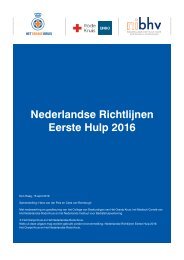Thesis-Anne-Vos-Masters-SBR-and-EU-Law-3
Thesis-Anne-Vos-Masters-SBR-and-EU-Law-3
Thesis-Anne-Vos-Masters-SBR-and-EU-Law-3
You also want an ePaper? Increase the reach of your titles
YUMPU automatically turns print PDFs into web optimized ePapers that Google loves.
The second question to be considered is whether the best available knowledge has been used to<br />
prevent possible negative consequences resulting from the decision <strong>and</strong>/or whether there are<br />
alternatives. This question has yet to be answered with regard to shale gas extraction. According to<br />
the Recommendation, the risk assessment (on the selection of the exploration <strong>and</strong> production site)<br />
should be based on the BAT <strong>and</strong> MS should ensure that operators use the BAT. In the Draft MSL<br />
of the Dutch Minister of Economic Affairs, no clear reference has (yet) been made to the BAT.<br />
Moreover, according to Van Hees, this discussion can be held from two different perspectives.<br />
From the point of view of e.g. the NGOs, it could be argued that there are many (cleaner)<br />
alternatives for shale gas extraction, especially the use of renewable energy resources. However, it<br />
could also be argued, by e.g. the permit holders <strong>and</strong> the Minister of Economic Affairs, that (shale)<br />
gas is the cleanest fossil fuel. Therefore, it could be stated that the best available knowledge was<br />
used. Moreover, it is not economically <strong>and</strong> technically viable to solely use renewable energy,<br />
because it is not possible for a country to only use renewable energy, since many of those<br />
resources are dependent on the amount of e.g. wind or sun. Therefore, some other energy<br />
resources have to be used as well. It can be argued (as done by the Dutch Minister of Economic<br />
Affairs) that gas-fired power plants are ideal to use in combination with renewable energy, because<br />
they can easily be adjusted or turned off <strong>and</strong> therefore can be used flexible to support the changing<br />
dem<strong>and</strong> patterns of solar <strong>and</strong> wind energy. 431 It could also be questioned, from the perspective of<br />
the permit holders, whether there actually are alternatives available for them. After all, Cuadrilla<br />
B.V. in the Netherl<strong>and</strong>s is specialized in shale gas extraction, not in renewable energy <strong>and</strong> the<br />
building of a wind mill. For Cuadrilla B.V., no alternative is available. This question could thus be<br />
argued both ways. 432<br />
Then, it should be questioned whether there is scientific uncertainty about the existence or extent<br />
of risks to public health, safety or the environment stemming from the decision <strong>and</strong> if so, whether<br />
measures have been taken to prevent the occurrence of those risks. This question has already<br />
been answered with regard to shale gas in paragraph 6.4.1.<br />
Next, it should be assessed, if negative consequences stemming from the preferred option<br />
continue to exist, whether the decision is based on a sincere balancing act conducted between the<br />
positive economic effects of the decision <strong>and</strong> its negative (e.g. environmental) effects <strong>and</strong> whether<br />
the costs of these negative effects are borne by those who are responsible for causing them. This<br />
question is not easy to answer because it includes a political decision. Simply stated: which one of<br />
the three P's gets the most weight? The economic effects of shale gas production (security of<br />
energy supply, important source of energy, economically important, ensuring cheap energy mix) or<br />
the environmental effects (the protection of the environment, drinking water, etc.). In order to<br />
balance these policy objectives, it should be known how much weight they both have. This<br />
discussion is already held above <strong>and</strong> is difficult to conduct since there is no clear priority-rule<br />
available. However, as stated by the integration principle, at least both objectives have to be taken<br />
into consideration <strong>and</strong> some kind of balance has to be made. 433 This balancing act is political in<br />
nature. As stated earlier, it could be argued that the protection of drinking water should be given<br />
more weight; there is no alternative for this, while there are alternatives to secure the energy of<br />
supply. But again, this is an opinion which the government could set aside. Moreover, to argue in a<br />
different direction, when looking at the current political developments, it can also be argued that the<br />
economic effects (instead of the environmental effects) ensure the concept of sustainable<br />
development in this case. After all, if Russia shuts down the gas tap <strong>and</strong> the entire <strong>EU</strong> has to (in<br />
the worst case scenario) stoke wood, which again could lead to deforestation, this is also not in<br />
accordance with the concept of sustainable development.<br />
431<br />
Kamerstukken II 2012/13, 28 982, nr. 132, p. 2.<br />
432<br />
Van Hees (2014), p. 74.<br />
433<br />
Van Hees (2014), p. 67.<br />
93



